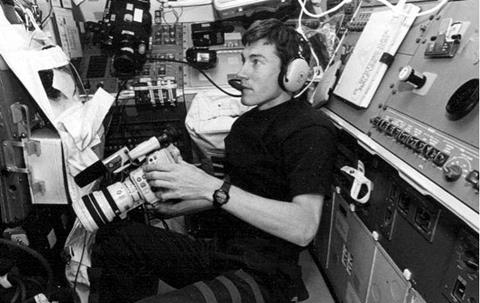STS-60
|
Int. Designation |
1994-006A |
|
Launched |
3 February 1994 |
|
Launch Site |
Pad 39A, Kennedy Space Center, Florida |
|
Landed |
11 February 1994 |
|
Landing Site |
Runway 15, Shuttle Landing Facility, Kennedy Space Center, Florida |
|
Launch Vehicle |
OV-103 Discovery/ET-61/SRB BI-062/SSME #1 2012; #2 2034; #3 2032 |
|
Duration |
8 days 7 hrs 9 min 22 sec |
|
Call sign |
Discovery |
|
Objective |
Wake Shield Facility 1 operations; SpaceHab 2; first flight of a Russian cosmonaut on a US mission |
Flight Crew
BOLDEN Jr., Charles Frank, 47, USMC, commander, 4th mission Previous missions: STS 61-C (1986); STS-31 (1990); STS-45 (1992) REIGHTLER Jr., Kenneth Stanley, 42, USN, pilot, 2nd mission Previous mission: STS-48 (1991)
DAVIS, Nancy Jan, 40, civilian, mission specialist 1, 2nd mission Previous mission: STS-47 (1991)
SEGA, Ronald Michael, 41, civilian, mission specialist 2
CHANG-DIAZ, Franklin Ramon, 43, civilian, mission specialist 3, 4th mission
Previous missions: STS 61-C (1986); STS-34 (1989); STS-46 (1992)
KRIKALEV, Sergei Konstaninovich, 35, civilian, Russian mission specialist 4, 3rd mission
Previous missions: Soyuz TM7 (1988); Soyuz TM12 (1991)
Flight Log
As part of the agreement between the US and Russia on manned space flight operations, the first Russian cosmonauts (Mir veterans Sergei Krikalev and Vladimir Titov) arrived at NASA JSC in Houston in late October 1992, to train for STS-60 and STS-63. Their training would be an abbreviated form of NASA mission specialist (not candidate) training, which would include RMS operations and EVA training using American EMU hardware. The training flow for the cosmonauts took into account their vast experience in the Russian programme. In February 1993, Krikalev was assigned the prime position on STS-60 with Titov as his back-up, reversing the roles for STS-63. These flights were the precursor missions that would include up to ten (later reduced to seven) long-duration American residencies on Mir, Shuttle dockings and further Russian cosmonauts incorporated into crews for Shuttle-Mir
|
Russia’s first cosmonaut to fly on the American Shuttle, Sergei Krikalev is seen on the aft flight deck of Discovery during the STS-60 mission. He uses the SAREX equipment to talk with American students in Maine and holds a camcorder for recording in-flight activities |
missions. This all fell under Phase 1 of the International Space Station programme, the sixteen-nation cooperative programme that essentially replaced both the US Space Station Freedom and Russian Mir 2 programmes.
The mission of STS-60 had been postponed from November 1993 and rescheduled for January 1994, but a leaking aft RCS thruster in the orbiter forced a further delay while it was investigated. On the third attempt, the launch occurred without incident and the SpaceHab experiments were activated shortly after reaching orbit. The twelve experiments in the programme included four in materials sciences, seven in life sciences and a space dust collection experiment. On the third flight day, the crew attempted to deploy the Wake Shield Facility, but radio interference and problems in reading status information from the facility meant that the attempt had to be abandoned. The following day, the deployment was again cancelled when the facility’s attitude control system developed problems. For two days, the facility remained on the end of the robot arm, conducting abbreviated experiments and being berthed during FD 6. The Wake Shield Facility was planned as a deployable and retrievable experiment platform that would leave a vacuum wake in low-Earth orbit, which was calculated as being 10,000 times greater than that created on Earth in the laboratory. Within this “ultra-vacuum” environment, it was planned to grow defect-free thin film layers of semi-conductor materials (such as gallium arsenide).
Two experiments deployable from GAS canisters (six orbital debris calibration spheres – ranging from 5 to 15 cm in diameter, and a German satellite that measured acceleration forces) were carried on the flight, as well as three other GAS canister experiments. There was also a capillary pump experiment and an auroral photography experiment included in the science package. Krikalev had been given crew roles in photography and TV tasks, as well as maintenance activities during the flight. He supported SpaceHab systems and RMS operations and participated in the Earth observation programme. He was also assigned roles in some of the secondary experiments on the mission. His primary role was participation in the joint in-flight medical and radiological investigations. Krikalev also used the SAREX ham radio equipment to talk with operators in Moscow. After a one-orbit waive-off due to unfavourable weather at KSC, the mission ended with a perfect landing, a successful opening of the series of cooperative missions that would lead to the ISS programme.
The most significant achievement was that a cosmonaut could be trained to work with an American crew on an American mission in such a short time. This was a strong reflection of the capabilities of Krikalev, who took to both the English language and the American training system more easily than Titov. It was also a compliment to the vast experience both men brought from their own programme. Krikalev had more than 400 days experience from two missions and Titov had logged a year in space on one mission. The Russians seemed to integrate well with the American programme, but the question now was whether the Americans could do the same when they had to spend far longer in Russia training for a residency on Mir.
Milestones
167th manned space flight 90th US manned space flight 60th Shuttle mission 18th flight of Discovery 1st Russian cosmonaut on Shuttle
1st cosmonaut not to be launched from Baikonur or land in Russian territory 1st flight of Wake Shield Facility 100th Get Away Special (GAS) payload











